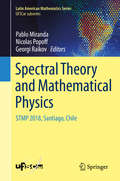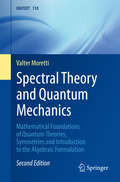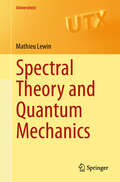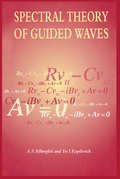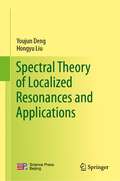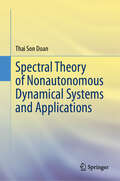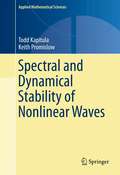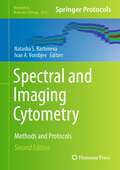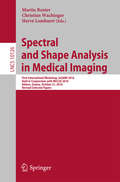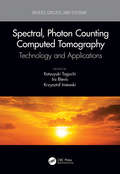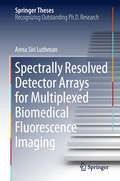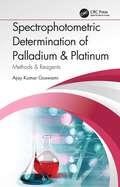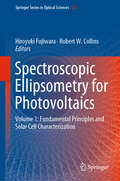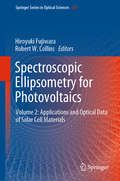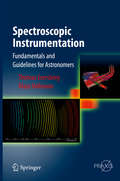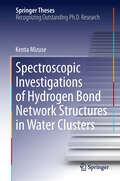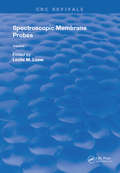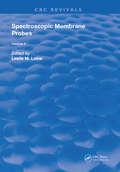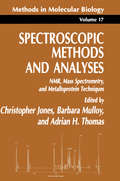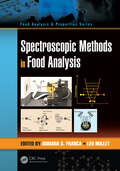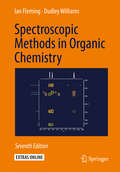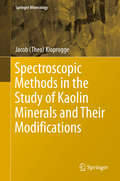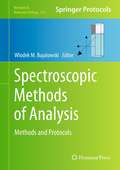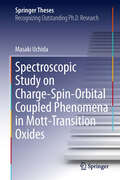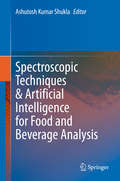- Table View
- List View
Spectral Theory and Mathematical Physics: STMP 2018, Santiago, Chile (Latin American Mathematics Series #254)
by Georgi Raikov Pablo Miranda Nicolas PopoffThis proceedings volume contains peer-reviewed, selected papers and surveys presented at the conference Spectral Theory and Mathematical Physics (STMP) 2018 which was held in Santiago, Chile, at the Pontifical Catholic University of Chile in December 2018. The original works gathered in this volume reveal the state of the art in the area and reflect the intense cooperation between young researchers in spectral theoryand mathematical physics and established specialists in this field. The list of topics covered includes: eigenvalues and resonances for quantum Hamiltonians; spectral shift function and quantum scattering; spectral properties of random operators; magnetic quantum Hamiltonians; microlocal analysis and its applications in mathematical physics. This volume can be of interest both to senior researchers and graduate students pursuing new research topics in Mathematical Physics.
Spectral Theory and Quantum Mechanics
by Valter MorettiThis book pursues the accurate study of the mathematical foundations of Quantum Theories. It may be considered an introductory text on linear functional analysis with a focus on Hilbert spaces. Specific attention is given to spectral theory features that are relevant in physics. Having left the physical phenomenology in the background, it is the formal and logical aspects of the theory that are privileged. Another not lesser purpose is to collect in one place a number of useful rigorous statements on the mathematical structure of Quantum Mechanics, including some elementary, yet fundamental, results on the Algebraic Formulation of Quantum Theories. In the attempt to reach out to Master's or PhD students, both in physics and mathematics, the material is designed to be self-contained: it includes a summary of point-set topology and abstract measure theory, together with an appendix on differential geometry. The book should benefit established researchers to organise and present the profusion of advanced material disseminated in the literature. Most chapters are accompanied by exercises, many of which are solved explicitly.
Spectral Theory and Quantum Mechanics (Universitext)
by Mathieu LewinThis textbook presents the spectral theory of self-adjoint operators on Hilbert space and its applications in quantum mechanics. Based on a course taught by the author in Paris, the book not only covers the mathematical theory but also provides its physical interpretation, offering an accessible introduction to quantum mechanics for students with a background in mathematics. The presentation incorporates numerous physical examples to illustrate the abstract theory. The final two chapters present recent findings on Schrödinger’s equation for systems of particles. While primarily designed for graduate courses, the book can also serve as a valuable introduction to the subject for more advanced readers. It requires no prior knowledge of physics, assuming only a graduate-level understanding of mathematical analysis from the reader.
Spectral Theory of Guided Waves
by A.S Silbergleit Y KopilevichSpectral Theory of Guided Waves represents a distillation of the authors' (and others) efforts over several years to rigorously discuss many of the properties of guided waves. The bulk of the book deals with the properties of eigenwaves of regular waveguiding systems and relates these to a variety of physical situations and applications to illustrate their generality. The book also includes considerable discussion of the basic properties of normal waves with quadratic operator pencils. Unique in its coverage of these subjects, the book will be of interest to engineers, applied mathematicians, and physicists with a working knowledge of functional analysis and spectral theory.
Spectral Theory of Localized Resonances and Applications
by Hongyu Liu Youjun DengThis book is devoted to the spectral theory of localized resonances including surface plasmon/polariton resonances, atypical resonances, anomalous localized resonances and interior transmission resonances. Those resonance phenomena arise in different physical contexts, but share similar features. They form the fundamental basis for many cutting-edge technologies and applications including invisibility cloaking and super-resolution imaging. The book presents a systematic and comprehensive treatment on these resonance phenomena and the associated applications in a unified manner from a mathematical and spectral perspective, covering acoustic, electromagnetic and elastic wave scattering.The book can serve as a handy reference book for researchers in this field and it can also serve as a textbook or an inspiring source for postgraduate students who are interested in entering this field.
Spectral Theory of Nonautonomous Dynamical Systems and Applications
by Thai Son DoanThe main challenge in the study of nonautonomous phenomena is to understand the very complicated dynamical behaviour both as a scientific and mathematical problem. The theory of nonautonomous dynamical systems has experienced a renewed and steadily growing interest in the last twenty years, stimulated also by synergetic effects of disciplines which have developed relatively independent for some time such as topological skew product, random dynamical systems, finite-time dynamics and control systems. The book provides new insights in many aspects of the qualitative theory of nonautonomous dynamical systems including the spectral theory, the linearization theory, the bifurcation theory. The book first introduces several important spectral theorem for nonautonomous differential equations including the Lyapunov spectrum, Sacker-Sell spectrum and finite-time spectrum. The author also establishes the smooth linearization and partial linearization for nonautonomous differential equations in application part. Then the second part recalls the multiplicative ergodic theorem for random dynamical systems and discusses several explicit formulas in computing the Lyapunov spectrum for random dynamical systems generated by linear stochastic differential equations and random difference equations with random delay. In the end, the Pitchfork bifurcation and Hopf bifurcation with additive noise are investigated in terms of change of the sign of Lyapunov exponents and loss of topological equivalence. This book might be appealing to researchers and graduate students in the field of dynamical systems, stochastic differential equations, ergodic theory.
Spectral and Dynamical Stability of Nonlinear Waves
by Keith Promislow Todd KapitulaThis book unifies the dynamical systems and functional analysis approaches to the linear and nonlinear stability of waves. It synthesizes fundamental ideas of the past 20+ years of research, carefully balancing theory and application. The book isolates and methodically develops key ideas by working through illustrative examples that are subsequently synthesized into general principles. Many of the seminal examples of stability theory, including orbital stability of the KdV solitary wave, and asymptotic stability of viscous shocks for scalar conservation laws, are treated in a textbook fashion for the first time. It presents spectral theory from a dynamical systems and functional analytic point of view, including essential and absolute spectra, and develops general nonlinear stability results for dissipative and Hamiltonian systems. The structure of the linear eigenvalue problem for Hamiltonian systems is carefully developed, including the Krein signature and related stability indices. The Evans function for the detection of point spectra is carefully developed through a series of frameworks of increasing complexity. Applications of the Evans function to the Orientation index, edge bifurcations, and large domain limits are developed through illustrative examples. The book is intended for first or second year graduate students in mathematics, or those with equivalent mathematical maturity. It is highly illustrated and there are many exercises scattered throughout the text that highlight and emphasize the key concepts. Upon completion of the book, the reader will be in an excellent position to understand and contribute to current research in nonlinear stability.
Spectral and Imaging Cytometry: Methods and Protocols (Methods in Molecular Biology #2635)
by Natasha S. Barteneva Ivan A. VorobjevThis second edition volume expands on the previous edition with discussions on the latest approaches used in the spectral cytometry field. Beginning with a brief history of spectral cytometry development, this book continues with a section addressing new protocols in different areas of imaging cytometry based on the unique technology of Imagestream and also introduces FlowCam – cytometer with capabilities of analyzing phytoplankton and zooplankton. Written for the highly successful Methods in Molecular Biology series, chapters include brief introductions to their respective topics, complete lists of the materials and reagents necessary, and reproducible laboratory protocols with tips on troubleshooting and recommendations.Cutting-edge and thorough, Spectral and Imaging Flow Cytometry: Methods and Protocols, Second Edition is a valuable resources for beginners and professionals interested in learning more about this developing field. Chapters 1, 2, and 5 are available open access under a Creative Commons Attribution 4.0 International License via link.springer.com.
Spectral and Shape Analysis in Medical Imaging
by Martin Reuter Christian Wachinger Hervé LombaertThis book constitutes the refereed post-conference proceedings of the First International Workshop on Spectral and Shape Analysis in Medical Imaging, SeSAMI 2016, held in conjunction with MICCAI 2016, in Athens, Greece, in October 2016. The 10 submitted full papers presented in this volume were carefully reviewed. The papers reflect the following topics: spectral methods; longitudinal methods; and shape methods.
Spectral, Photon Counting Computed Tomography: Technology and Applications (Devices, Circuits, and Systems)
by Krzysztof Iniewski Katsuyuki Taguchi Ira BlevisSpectral, Photon Counting Computed Tomography is a comprehensive cover of the latest developments in the most prevalent imaging modality (x-ray computed tomography (CT)) in its latest incarnation: Spectral, Dual-Energy, and Photon Counting CT. Disadvantages of the conventional single-energy technique used by CT technology are that different materials cannot be distinguished and that the noise is larger. To address these problems, a novel spectral CT concept has been proposed. Spectral Dual-Energy CT (DE-CT) acquires two sets of spectral data, and Spectral Photon Counting CT (PC-CT) detects energy of x-ray photons to reveal additional material information of objects by using novel energy-sensitive, photon-counting detectors. The K-edge imaging may be a gateway for functional or molecular CT. The book covers detectors and electronics, image reconstruction methods, image quality assessments, a simulation tool, nanoparticle contrast agents, and clinical applications for spectral CT.
Spectrally Resolved Detector Arrays for Multiplexed Biomedical Fluorescence Imaging (Springer Theses)
by Anna Siri LuthmanThis book describes the design, development, characterisation and application of two novel fluorescence imaging instruments based on spectrally resolved detector arrays (SRDAs). The simplest SRDA is the standard colour camera, which integrates a Bayer filter array of red, green and blue colour filters to replicate the colour sensing capability of the human eye. The SRDAs used in this book contain many more colours, ranging from 16 to over 100 colour channels. Using these compact, robust and low-cost detectors for biomedical applications opens new avenues of exploration that were not possible before, in particular, the use of spectral imaging in endoscopy. The work presented shows for the first time that not only can this new type of camera be used for fluorescence imaging, but also that it is able to resolve signals from up to 7 different dyes – a level of multiplexing not previously achieved in tissue with such compact and robust equipment. Furthermore, it reports the application of a bimodal endoscope performing both reflectance and fluorescence imaging using these cameras in an ex vivo pig oesophagus model.
Spectrophotometric Determination of Palladium & Platinum: Methods & Reagents
by Ajay Kumar GoswamiThis versatile resource consolidates available methods for the spectrophotometric determination of palladium and platinum and serves as a practical ready-to-use guide for those researching palladium and platinum and for those working in the field of medicinal metal complexes of the two metals. The beauty of spectrophotometric methods lies in their simplicity, convenience, and easy operability, not to mention their cost-effectiveness. They can be automated easily and are thus the most affordable methods for the below reasons: Address analysts from all areas of industry, research labs and postgraduate students of analytical or medicinal chemistry as well as material science Detail all recently developed methods for palladium and platinum determination using spectrophotometry in a single source. Organized so that anyone interested in a particular method using a specific reagent can go directly to those details Facilitates the development of better methods for specific conditions of a sample
Spectroscopic Ellipsometry for Photovoltaics: Volume 1: Fundamental Principles and Solar Cell Characterization (Springer Series in Optical Sciences #212)
by Hiroyuki Fujiwara Robert W. CollinsThis book provides a basic understanding of spectroscopic ellipsometry, with a focus on characterization methods of a broad range of solar cell materials/devices, from traditional solar cell materials (Si, CuInGaSe2, and CdTe) to more advanced emerging materials (Cu2ZnSnSe4, organics, and hybrid perovskites), fulfilling a critical need in the photovoltaic community.The book describes optical constants of a variety of semiconductor light absorbers, transparent conductive oxides and metals that are vital for the interpretation of solar cell characteristics and device simulations. It is divided into four parts: fundamental principles of ellipsometry; characterization of solar cell materials/structures; ellipsometry applications including optical simulations of solar cell devices and online monitoring of film processing; and the optical constants of solar cell component layers.
Spectroscopic Ellipsometry for Photovoltaics: Volume 2: Applications and Optical Data of Solar Cell Materials (Springer Series in Optical Sciences #214)
by Hiroyuki Fujiwara Robert W. CollinsSpectroscopic ellipsometry has been applied to a wide variety of material and device characterizations in solar cell research fields. In particular, device performance analyses using exact optical constants of component layers and direct analyses of complex solar cell structures are unique features of advanced ellipsometry methods. This second volume of Spectroscopic Ellipsometry for Photovoltaics presents various applications of the ellipsometry technique for device analyses, including optical/recombination loss analyses, real-time control and on-line monitoring of solar cell structures, and large-area structural mapping. Furthermore, this book describes the optical constants of 148 solar cell component layers, covering a broad range of materials from semiconductor light absorbers (inorganic, organic and hybrid perovskite semiconductors) to transparent conductive oxides and metals. The tabulated and completely parameterized optical constants described in this book are the most current resource that is vital for device simulations and solar cell structural analyses.
Spectroscopic Instrumentation
by Thomas Eversberg Klaus VollmannIn order to analyze the light of cosmic objects, particularly at extremely great distances, spectroscopy is the workhorse of astronomy. In the era of very large telescopes, long-term investigations are mainly performed with small professional instruments. Today they can be done using self-designed spectrographs and highly efficient CCD cameras, without the need for large financial investments. This book explains the basic principles of spectroscopy, including the fundamental optical constraints and all mathematical aspects needed to understand the working principles in detail. It covers the complete theoretical and practical design of standard and Echelle spectrographs. Readers are guided through all necessary calculations, enabling them to engage in spectrograph design. The book also examines data acquisition with CCD cameras and fiber optics, as well as the constraints of specific data reduction and possible sources of error. In closing it briefly highlights some main aspects of the research on massive stars and spectropolarimetry as an extension of spectroscopy. The book offers a comprehensive introduction to spectroscopy for students of physics and astronomy, as well as a valuable resource for amateur astronomers interested in learning the principles of spectroscopy and spectrograph design.
Spectroscopic Investigations of Hydrogen Bond Network Structures in Water Clusters
by Kenta MizuseThe properties and nature of water clusters studied with novel spectroscopic approaches are presented in this thesis. Following a general introduction on the chemistry of water and water clusters, detailed descriptions of the experiments and analyses are given. All the experimental results, including first size-selective spectra of large clusters consisting of 200 water molecules, are presented with corresponding analyses. Hitherto unidentified hydrogen bond network structures, dynamics, and reactivity of various water clusters have been characterized at the molecular level. The main targets of this book are physical chemists and chemical physicists who are interested in water chemistry or cluster chemistry.
Spectroscopic Membrane Probes: Volume 1
by Leslie M. LoewThe general picture we have of membranes and of the properties of the proteins imbedded in them, has, arguably emerged directly from probe studies over the past 20 years. This work is designed to make these techniques accessible to a board audience of cell biologists. The techniques discussed revolve primarily around the fluorescence of membrane probes, but applications of light absorption and Raman scattering are included. In addition to reviews of the major applications, most chapters include information on the required apparatus, experimental design, data analysis, and potential pit falls.
Spectroscopic Membrane Probes: Volume 2
by Leslie M. LoewThe optical spectra of molecular membrane probes can be interpreted terms of the structure, dynamics, and the physiological state of the membrane. The general picture we have of membranes and of the properties of the proteins imbedded in them, has, arguably, emerged directly from probe studies over the last 20 years. This work is designed to make these techniques accessible to a broad audience of cell biologist. The techniques discussed revolve primarily around the fluorescence of membrane probes, but applications of light absorption and Raman scattering are included. In addition to reviews of the major applications, most chapters include information on required apparatus, experimental design, data analysis, and potential pitfalls.
Spectroscopic Methods and Analyses
by Adrian H. Thomas Christopher Jones Barbara MulloyAlthough spectroscopic methods are of great use to biological scientists, many researchers lack a specialist's knowledge of these techniques. Spectroscopic Methods and Analyses provides hands-on information on these valuable research tools, emphasizing practical aspects, such as amounts and purity of required samples, limitations and advantages of the technique, and interpretation of the results, thus enabling every molecular biologist-either independently or with the help of a specialist-to evaluate the usefulness of a technique, to plan an original program, and to gain a realistic idea of the resources needed.An indispensable guide for all biochemists, cell and molecular biologists, pharmacologists, immunologists, pathologists, and neuroscientists.
Spectroscopic Methods in Food Analysis (Food Analysis & Properties)
by Leo M.L. Nollet Adriana S. FrancaGiven the inherent complexity of food products, most instrumental techniques employed for quality and authenticity evaluation (e.g., chromatographic methods) are time demanding, expensive, and involve a considerable amount of manual labor. Therefore, there has been an increasing interest in simpler, faster, and reliable analytical methods for assessing food quality attributes. Spectroscopic Methods in Food Analysis presents the basic concepts of spectroscopic methods, together with a discussion on the most important applications in food analysis. The determination of product quality and authenticity and the detection of adulteration are major issues in the food industry, causing concern among consumers and special attention among food manufacturers. As such, this book explains why spectroscopic methods have been extensively employed to the analysis of food products as they often require minimal or no sample preparation, provide rapid and on-line analysis, and have the potential to run multiple tests on a single sample (i.e., non-destructive). This book consists of concepts related to food quality and authenticity, that are quite broad, given the different demands of the manufacturer, the consumer, the surveillance and the legislative bodies that ultimately provide healthy and safe products.
Spectroscopic Methods in Organic Chemistry: 7th Edition
by Ian Fleming Dudley WilliamsThis book is a well-established guide to the interpretation of the mass, ultraviolet, infrared and nuclear magnetic resonance spectra of organic compounds. It is designed for students of organic chemistry taking a course in the application of these techniques to structure determination. The text also remains useful as a source of data for organic chemists to keep on their desks throughout their career. In the seventh edition, substantial portions of the text have been revised reflecting knowledge gained during the author's teaching experience over the last seven years. The chapter on NMR has been divided into two separate chapters covering the 1D and 2D experiments. The discussion is also expanded to include accounts of the physics at a relatively simple level, following the development of the magnetization vectors as each pulse sequence is introduced. The emphasis on the uses of NMR spectroscopy in structure determination is retained. Worked examples and problem sets are included on a chapter level to allow students to practise their skills by determining the chemical structures of unknown compounds.
Spectroscopic Methods in the Study of Kaolin Minerals and Their Modifications (Springer Mineralogy Ser.)
by Jacob Theo KloproggeThis book systematically provides an overview of the use of a wide range of spectroscopic methods (Mid- and Near-Infrared, Infrared Emission, Raman, Solid-State Magic Angle Spinning Nuclear Magnetic Resonance, X-ray Photoelectron, Extended X-ray Absorption Fine Structure, X-ray Absorption Near Edge, Electron Spin and Mössbauer spectroscopy) to investigate kaolin minerals (kaolinite, dickite, nacrite and halloysite) and their modifications (intercalation compounds, nanocomposites and other modifications).
Spectroscopic Methods of Analysis
by Wlodek M. BujalowskiQuantitative elucidation of structural, energetic and dynamic aspects of macromolecular interactions is indispensable for understanding the functional activities of biomolecules and their interactions. The optical spectroscopic methods are not confined to small molecules or macromolecules but permit the studies of even the largest biological systems in their full splendor, including the living cell. In, Spectroscopic Methods of Analysis: Methods and Protocols, expert researchers in the field detail many of the methods which are now commonly used to study properties of individual macromolecules, their complexes, organelles, and cells, using optical spectroscopic techniques. These include methods and approaches for experimental and theoretical analyses of fluorescence properties of the examined systems, single molecule approaches, electronic absorption, and electro-optical analyses of macromolecular interactions, structures, and dynamics. Written in the highly successful Methods in Molecular Biology(tm) series format, chapters include introductions to their respective topics, lists of the necessary materials and reagents, step-by-step laboratory protocols, and key tips on troubleshooting and avoiding known pitfalls. Authoritative and practical, Spectroscopic Methods of Analysis : Methods and Protocols seeks to aid scientists in the further study of optical spectroscopic methods.
Spectroscopic Study on Charge-Spin-Orbital Coupled Phenomena in Mott-Transition Oxides
by Masaki UchidaIn this thesis the author presents the results of extensive spectroscopy experiments beyond the bounds of each transition element to clarify the origins of characteristic spectral features and charge dynamics in charge-spin-orbital coupled phenomena in Mott-transition oxides. Several counterpart 3d transition-metal oxides were adopted as model systems suitable for examining the mechanisms involved, and their electronic structures were systematically investigated using three main spectroscopy methods. Comparative studies on the charge dynamics and Mott transition features of transition-metal oxides were performed: Charge dynamics and thermoelectricity in a typical Mott transition system La1--xSrxVO3, charge dynamics in a doped valence-bond solid system (Ti1--xVx)2O3 and in layered nickelates R2-xSrxNiO4 with charge-ordering instability are investigated thoroughly. The results obtained successfully provide a number of novel insights into the emergent phenomena near the Mott transition.
Spectroscopic Techniques & Artificial Intelligence for Food and Beverage Analysis
by Ashutosh Kumar ShuklaThis informative book discusses the various spectroscopic techniques applied in the analysis of food and beverages. The respective chapters cover techniques such as Laser-Induced Breakdown Spectroscopy (LIBS), FTIR spectroscopy, Electron Spin Resonance (ESR) spectroscopy and Thermoluminescence. The book also presents artificial intelligence applications that can be used to enhance the spectral data analysis experience in food safety and quality analysis. Given its scope, the book will appeal to novice researchers and students in the area of food science. It offers an equally exciting read for food scientists and engineers working in the food industry.
